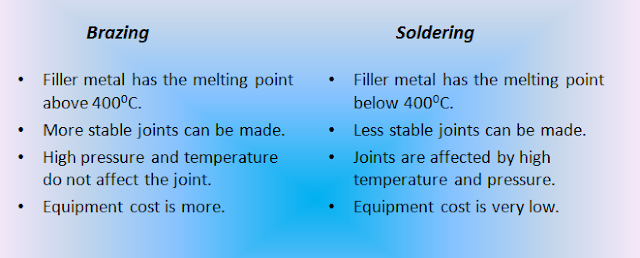SOLDERING
1. Hard solder: It is an alloy of copper and zinc.
2. Soft solder: It is an alloy of tin and lead.
PROCESS
The surface to be joined are cleaned and are placed on each other. A flux is employed to prevent oxidation. Zinc chloride is commonly used for this purpose. The soldering iron is heated either electrically or by some external heat. Then the hot end is dipped into the flux and solder is pressed against the surfaces to be joined. A joint is formed by melting the solder.APPLICATIONS
Soldering is widely used for sheet metal work and in radio and television work for joining wires.ADVANTAGES
1. Joining cost is low.2. Equipment is very simple and cheap.
3. Good sealing in fabrication as compared to other processes like rivet, spot weld and bolts.
4. It provides a positive electrical connection.
5. Due to low operating temperature, the properties of base metal are not affected.
DISADVANTAGES
Joint formed are quite weak.BRAZING
The process of joining two metal surfaces by heating and adding a non-ferrous alloy with melting point above 400 C is known as brazing.
PROCESS
The surface to be joined are cleaned from all oil, dirt or oxides. Then both the surfaces are placed in joining positions. Flux is sprinkled or placed on it. The heat is given to the surface and the filler metal. The molten filler metal flows to the surfaces to be joined. On cooling brazing joint is formed. The filler metal used are copper alloy, silver alloy and aluminium alloy. In brazing the filler metal melts but the surfaces to be joined remain un-melted. The various methods used to melt the filler metal and flux are:1. Gas torch brazing:
It is a commonly used process in which oxy-acetylene torch is used.
2. Furnace brazing:
The surfaces to be joined are placed in a furnace already hot.
3. Dip brazing:
The surfaces to be joined are dipped in molten filler metal.
4. Electrical brazing:
In electric brazing heat is produced by resistance or induction method.
APPLICATIONS
Brazing is used for electrical items, radiators, heat exchangers, pipes and pipe fittings and tool tips.ADVANTAGES
1. It is useful for joining dissimilar metals.2. Thin sections can be easily joined.
3. Good finish is obtained on joint.
4. High production
5. Less skill is required.
6. Cost of operation is less as compared to other welding processes.
DISADVANTAGES
1. Low strength.2. Not applicable for hardened steel and aluminium alloys.







Thank you so much as you have been willing to share information with us. We will forever admire all you have done here.
ReplyDeleteCabinet Handles India
Great information on blog. keep posting more blogs.
ReplyDeletewe are Welding Torch Dealers in Ambala.